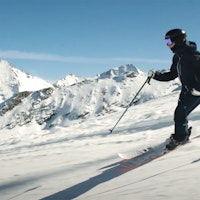MORE IN THIS SERIES:
• PART II: AVALANCHE TERRAIN
• PART III: AVALANCHE BURIALS AND SEARCHING TIPS
• PART IV: DIGGING PITS AND WARNING SIGNS
Nat Patridge, President and Director of Operations for Exum Mountian Guides, shared his 17 years of guiding and forecasting experience with us to create this guide. The AMGA certified guide has forecasted for the backcountry guide department at Jackson Hole Mountain Resort and is a former lead forecaster at High Mountain Heli and Valdez Heli Ski Guides. The 40-year-old Jackson based guide says it all comes down to careful “observation and confirmation” throughout the entire winter, paying attention to avalanche cycles, weather, temperatures and snowfall.
“Remember, skiing is a lifetime sport and in order to enjoy it, you need to live a long life,” says Patridge. “Think long term with your descent goals. It may not be this year that you get to ski that great line, but maybe you’ll rip it a decade from now.”
Celebrating its 80th year in business, Jackson, Wyoming based Exum Mountain Guides has built a legacy of guiding that incorporates personal responsibility and self- sufficiency into its philosophy.
Founder Glenn Exum was turned off by what he saw in European guiding—no education, no instruction on technique—simply a “haul them up” approach. When he returned to the states, Exum began guiding in his home range, the Tetons, where the emphasis was to provide instruction, show techniques, and to promote education and participation.
Eight decades later, Exum Guides’ philosophy continues to be education-based, offering experiences that allow the client or student to actively participate. Exum’s winter program has grown to provide avalanche awareness classes, backcountry skiing tours, ski mountaineering, winter skills programs, ice climbing, and even a guided ski tour of the Grand Teton.
“It’s a broad spectrum,” say veteran guide Kent McBride. “We match our guiding with the client’s needs, while providing a groundwork of education and participation into their experience.”
Exum teaches the tools of the trade before heading into the backcountry. Hands-on beacon use, route finding skills, travel techniques, basic rescue skills and avalanche science are all discussed before leaving the trailhead.
“If the client is willing,” says McBride, “There’s no end to the learning process.”
For programming info, visit exumguides.com.
2. Risk doesn’t lessen as you descend farther down a slope. In the Tetons, the bathtub effect (a dramatic inversion) causes surface hoar to grow under the inversion layer,
meaning surface hoar hazard increases as you descend down in elevation.
3. “Safe zones” need to be significant terrain features. Not a single big boulder or a few trees.
4. Wait for confirmation of stability. Let the ski town lab rats do the work.
5. When skiing in big terrain, work the margins of the slope on the uphill and downhill. That means from the very top down and from the sides in. Resist center punching
the slope unless you are certain of the stability.
6. Choose partners who make good decisions and who are supportive to all members of the group.
7. Collect stability information from the moment you wake up. Use avalanche bulletins, visual clues, verbal reports, hasty hand pits, pole tests, ski cuts, and finally a pit.
8. Learn to dig a pit in less than 15 minutes. This pit should include a shovel shear test, two to three compression tap tests and the extended column test.
9. Doug Coombs was one of the first proponents of skiing smoothly. The difference between “snow punchers” triggering more slides than smooth skiers is a subtle one, but applicable to experienced users.
10. Intuition is the result of experience. Listen to the most conservative opinion within the group if they have a hunch.
• PART II: AVALANCHE TERRAIN
• PART III: AVALANCHE BURIALS AND SEARCHING TIPS
• PART IV: DIGGING PITS AND WARNING SIGNS
Get Freeskier on your iPhone/iPad: itunes.apple.com/app/freeskier-mag/id499829265?mt=8.
![[GIVEAWAY] Win a Head-to-Toe Ski Setup from IFSA](https://www.datocms-assets.com/163516/1765920344-ifsa.jpg?w=200&h=200&fit=crop)
![[GIVEAWAY] Win a Legendary Ski Trip with Icelantic's Road to the Rocks](https://www.datocms-assets.com/163516/1765233064-r2r26_freeskier_leaderboard1.jpg?w=200&h=200&fit=crop)


![[GIVEAWAY] Win a Legendary Ski Trip with Icelantic's Road to the Rocks](https://www.datocms-assets.com/163516/1765233064-r2r26_freeskier_leaderboard1.jpg?auto=format&w=400&h=300&fit=crop&crop=faces,entropy)




![[GIVEAWAY] Win a Head-to-Toe Ski Setup from IFSA](https://www.datocms-assets.com/163516/1765920344-ifsa.jpg?auto=format&w=400&h=300&fit=crop&crop=faces,entropy)

